2013 NISSAN GT-R transmission oil
[x] Cancel search: transmission oilPage 22 of 346
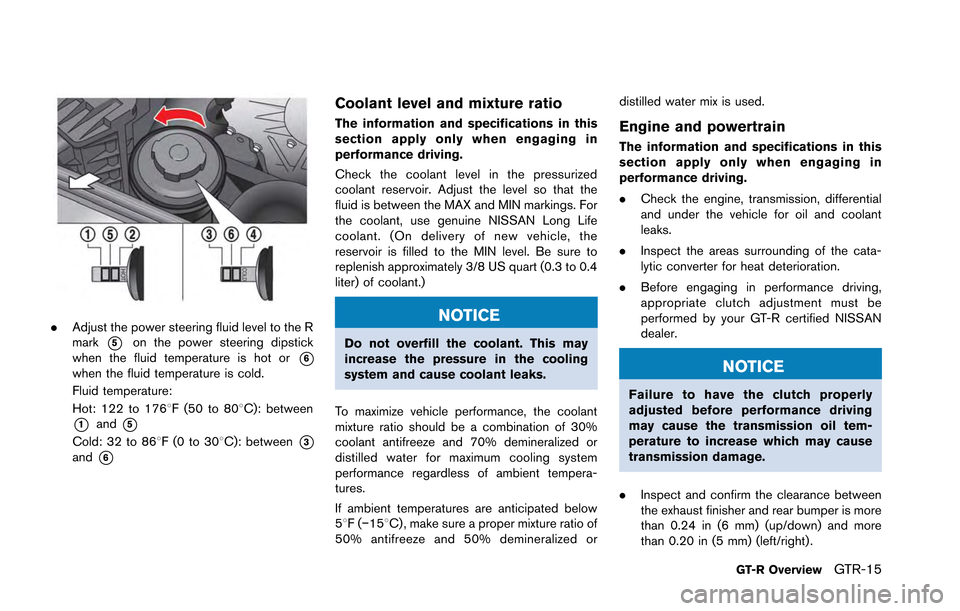
.Adjust the power steering fluid level to the R
mark
*5on the power steering dipstick
when the fluid temperature is hot or
*6when the fluid temperature is cold.
Fluid temperature:
Hot: 122 to 1768F (50 to 808C): between
*1and*5
Cold: 32 to 868F(0to30 8C): between*3and*6
Coolant level and mixture ratio
The information and specifications in this
section apply only when engaging in
performance driving.
Check the coolant level in the pressurized
coolant reservoir. Adjust the level so that the
fluid is between the MAX and MIN markings. For
the coolant, use genuine NISSAN Long Life
coolant. (On delivery of new vehicle, the
reservoir is filled to the MIN level. Be sure to
replenish approximately 3/8 US quart (0.3 to 0.4
liter) of coolant.)
NOTICE
Do not overfill the coolant. This may
increase the pressure in the cooling
system and cause coolant leaks.
To maximize vehicle performance, the coolant
mixture ratio should be a combination of 30%
coolant antifreeze and 70% demineralized or
distilled water for maximum cooling system
performance regardless of ambient tempera-
tures.
If ambient temperatures are anticipated below
58F( −158C) , make sure a proper mixture ratio of
50% antifreeze and 50% demineralized or distilled water mix is used.
Engine and powertrain
The information and specifications in this
section apply only when engaging in
performance driving.
.
Check the engine, transmission, differential
and under the vehicle for oil and coolant
leaks.
. Inspect the areas surrounding of the cata-
lytic converter for heat deterioration.
. Before engaging in performance driving,
appropriate clutch adjustment must be
performed by your GT-R certified NISSAN
dealer.
NOTICE
Failure to have the clutch properly
adjusted before performance driving
may cause the transmission oil tem-
perature to increase which may cause
transmission damage.
. Inspect and confirm the clearance between
the exhaust finisher and rear bumper is more
than 0.24 in (6 mm) (up/down) and more
than 0.20 in (5 mm) (left/right) .
GT-R OverviewGTR-15
Page 26 of 346
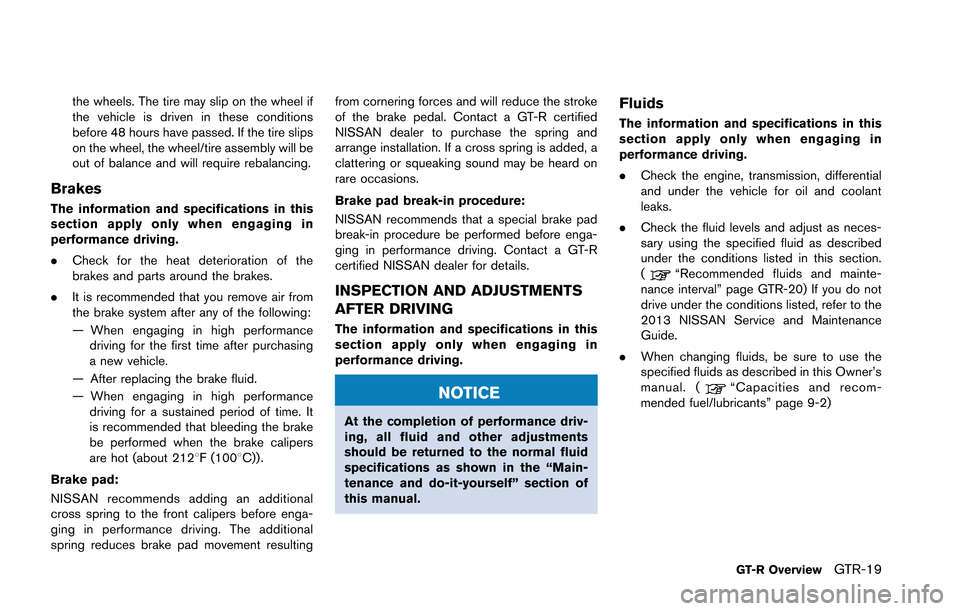
the wheels. The tire may slip on the wheel if
the vehicle is driven in these conditions
before 48 hours have passed. If the tire slips
on the wheel, the wheel/tire assembly will be
out of balance and will require rebalancing.
Brakes
The information and specifications in this
section apply only when engaging in
performance driving.
.Check for the heat deterioration of the
brakes and parts around the brakes.
. It is recommended that you remove air from
the brake system after any of the following:
— When engaging in high performance
driving for the first time after purchasing
a new vehicle.
— After replacing the brake fluid.
— When engaging in high performance driving for a sustained period of time. It
is recommended that bleeding the brake
be performed when the brake calipers
are hot (about 2128F (1008C)) .
Brake pad:
NISSAN recommends adding an additional
cross spring to the front calipers before enga-
ging in performance driving. The additional
spring reduces brake pad movement resulting from cornering forces and will reduce the stroke
of the brake pedal. Contact a GT-R certified
NISSAN dealer to purchase the spring and
arrange installation. If a cross spring is added, a
clattering or squeaking sound may be heard on
rare occasions.
Brake pad break-in procedure:
NISSAN recommends that a special brake pad
break-in procedure be performed before enga-
ging in performance driving. Contact a GT-R
certified NISSAN dealer for details.
INSPECTION AND ADJUSTMENTS
AFTER DRIVING
The information and specifications in this
section apply only when engaging in
performance driving.
NOTICE
At the completion of performance driv-
ing, all fluid and other adjustments
should be returned to the normal fluid
specifications as shown in the “Main-
tenance and do-it-yourself” section of
this manual.
Fluids
The information and specifications in this
section apply only when engaging in
performance driving.
.
Check the engine, transmission, differential
and under the vehicle for oil and coolant
leaks.
. Check the fluid levels and adjust as neces-
sary using the specified fluid as described
under the conditions listed in this section.
(
“Recommended fluids and mainte-
nance interval” page GTR-20) If you do not
drive under the conditions listed, refer to the
2013 NISSAN Service and Maintenance
Guide.
. When changing fluids, be sure to use the
specified fluids as described in this Owner’s
manual. (
“Capacities and recom-
mended fuel/lubricants” page 9-2)
GT-R OverviewGTR-19
Page 28 of 346
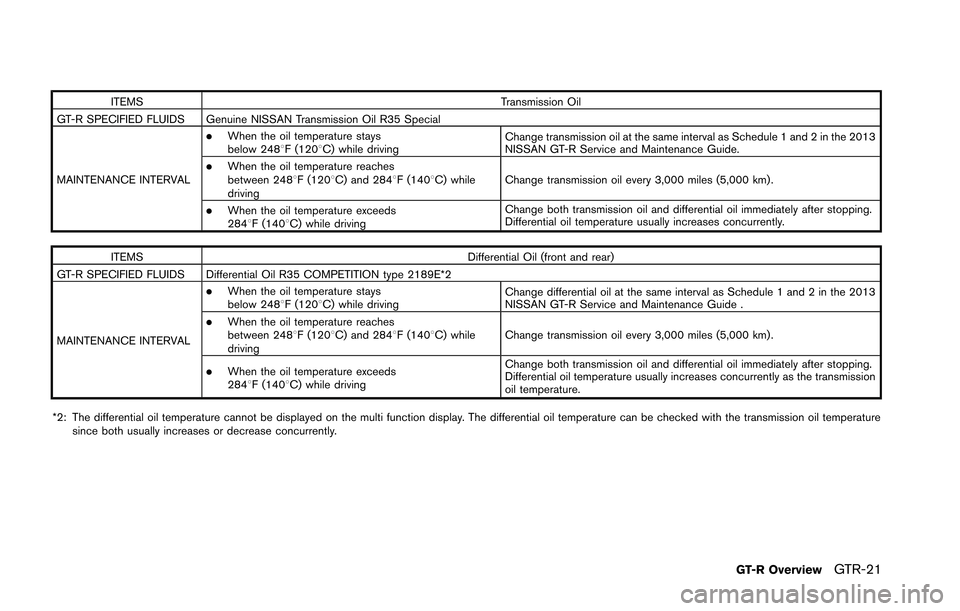
ITEMSTransmission Oil
GT-R SPECIFIED FLUIDS Genuine NISSAN Transmission Oil R35 Special
MAINTENANCE INTERVAL
.When the oil temperature stays
below 2488F (1208C) while driving Change transmission oil at the same interval as Schedule 1 and 2 in the 2013
NISSAN GT-R Service and Maintenance Guide.
.When the oil temperature reaches
between 2488F (1208C) and 2848F (1408C) while
drivingChange transmission oil every 3,000 miles (5,000 km) .
.When the oil temperature exceeds
2848F (1408C) while drivingChange both transmission oil and differential oil immediately after stopping.
Differential oil temperature usually increases concurrently.
ITEMS Differential Oil (front and rear)
GT-R SPECIFIED FLUIDS Differential Oil R35 COMPETITION type 2189E*2
MAINTENANCE INTERVAL
.When the oil temperature stays
below 2488F (1208C) while driving Change differential oil at the same interval as Schedule 1 and 2 in the 2013
NISSAN GT-R Service and Maintenance Guide .
.When the oil temperature reaches
between 2488F (1208C) and 2848F (1408C) while
drivingChange transmission oil every 3,000 miles (5,000 km) .
.When the oil temperature exceeds
2848F (1408C) while drivingChange both transmission oil and differential oil immediately after stopping.
Differential oil temperature usually increases concurrently as the transmission
oil temperature.
*2: The differential oil temperature cannot be displayed on the multi function display. The differential oil temperature can be checked with the transmission oil temperature since both usually increases or decrease concurrently.
GT-R OverviewGTR-21
Page 30 of 346

Suspension and wheel alignment
.Check the steering and suspension system
and other links for loose and/or damaged
parts.
. Measure and adjust the wheel alignment.
Contact a GT-R certified NISSAN dealer to
adjust the wheel alignment to the recom-
mended setting for normal driving.
Wheels and tires
.Check tire wear and cracking.
. Inspect the tire side wall for damage.
. Check the tire pressure and adjust the
pressure as necessary when the tires are
cold. (
“Wheels and tires” page GTR-
16) If you do not drive under the conditions
listed in this section, see (
“Wheels and
tires” page 8-31)
. Check that the wheel nuts are not stripped.
Check if there is no deformation on the
contact surface of the wheel nuts.
. Make sure the wheel nuts are tight.
(
“Wheels and tires” page 8-31)
. Make sure the drive shaft nuts are tight.
. Check wheel hub run out and that the wheel
rotates smoothly without any friction. Check
these with the tires removed whenever an inspection is performed with the vehicle
jacked up.
. Make sure the tire has not slipped on the
wheel causing the assembly to be out of
balance. The reference marks on the tire and
wheel should be aligned. If the reference
marks are not aligned, the tire has slipped on
the wheel. Have the wheels/tires reba-
lanced. Make sure the old reference marks
are erased and new reference marks are
applied to the wheel and tire. When instal-
ling new tires on the wheels, make sure new
reference marks are applied to the wheels
and tires. (
“Wheels and tires” page
GTR-16)
. Make sure that the TPMS sensor installation
nuts and the sensor valve are tight and there
is no nitrogen leak.
Brakes
.Check for the heat deterioration of the
brakes and parts around the brakes.
. Check the condition of the brake pads and
disc rotors and replace them as necessary.
Engine and powertrain
.Check the engine, transmission, differential
and under the vehicle for oil and coolant leaks.
. Inspect the area surrounding the catalytic
converter for heat deterioration.
. Inspect and confirm the clearance between
the exhaust finisher and rear bumper is more
than 0.24 in (6 mm) (up/down) and more
than 0.20 in (5 mm) (left/right) .
. The clutch clearance and shift fork position
may need to be adjusted.
. Inspect the dust boot of the drive shaft
universal joint for cracks or damage.
. Check that there is no abnormal noise,
vibrations or warning lights illuminated when
making tight turns at slow speed (for tight
corner braking phenomenon) .
GT-R OverviewGTR-23
Page 34 of 346
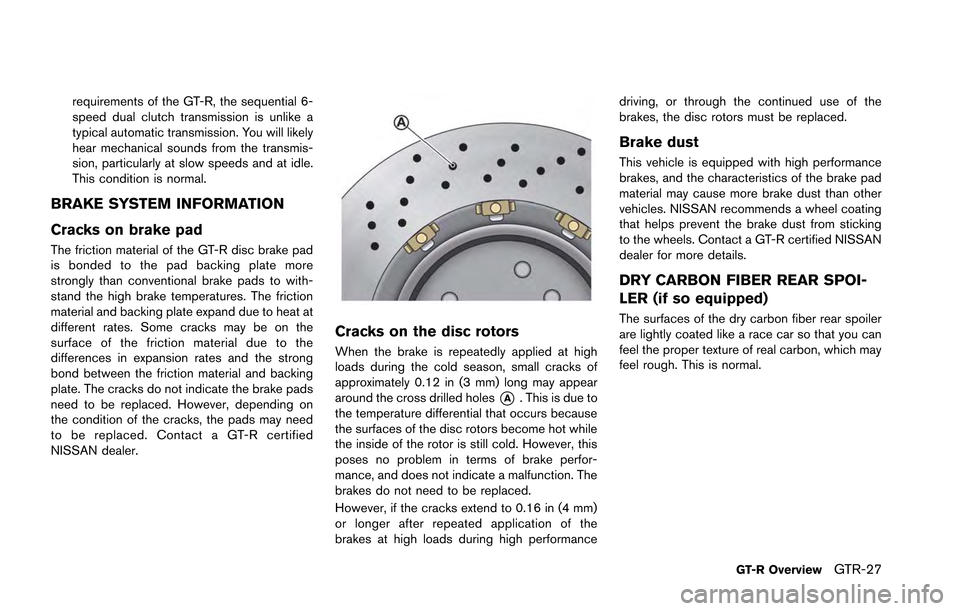
requirements of the GT-R, the sequential 6-
speed dual clutch transmission is unlike a
typical automatic transmission. You will likely
hear mechanical sounds from the transmis-
sion, particularly at slow speeds and at idle.
This condition is normal.
BRAKE SYSTEM INFORMATION
Cracks on brake pad
The friction material of the GT-R disc brake pad
is bonded to the pad backing plate more
strongly than conventional brake pads to with-
stand the high brake temperatures. The friction
material and backing plate expand due to heat at
different rates. Some cracks may be on the
surface of the friction material due to the
differences in expansion rates and the strong
bond between the friction material and backing
plate. The cracks do not indicate the brake pads
need to be replaced. However, depending on
the condition of the cracks, the pads may need
to be replaced. Contact a GT-R certified
NISSAN dealer.
Cracks on the disc rotors
When the brake is repeatedly applied at high
loads during the cold season, small cracks of
approximately 0.12 in (3 mm) long may appear
around the cross drilled holes
*A. This is due to
the temperature differential that occurs because
the surfaces of the disc rotors become hot while
the inside of the rotor is still cold. However, this
poses no problem in terms of brake perfor-
mance, and does not indicate a malfunction. The
brakes do not need to be replaced.
However, if the cracks extend to 0.16 in (4 mm)
or longer after repeated application of the
brakes at high loads during high performance driving, or through the continued use of the
brakes, the disc rotors must be replaced.
Brake dust
This vehicle is equipped with high performance
brakes, and the characteristics of the brake pad
material may cause more brake dust than other
vehicles. NISSAN recommends a wheel coating
that helps prevent the brake dust from sticking
to the wheels. Contact a GT-R certified NISSAN
dealer for more details.
DRY CARBON FIBER REAR SPOI-
LER (if so equipped)
The surfaces of the dry carbon fiber rear spoiler
are lightly coated like a race car so that you can
feel the proper texture of real carbon, which may
feel rough. This is normal.
GT-R OverviewGTR-27
Page 36 of 346
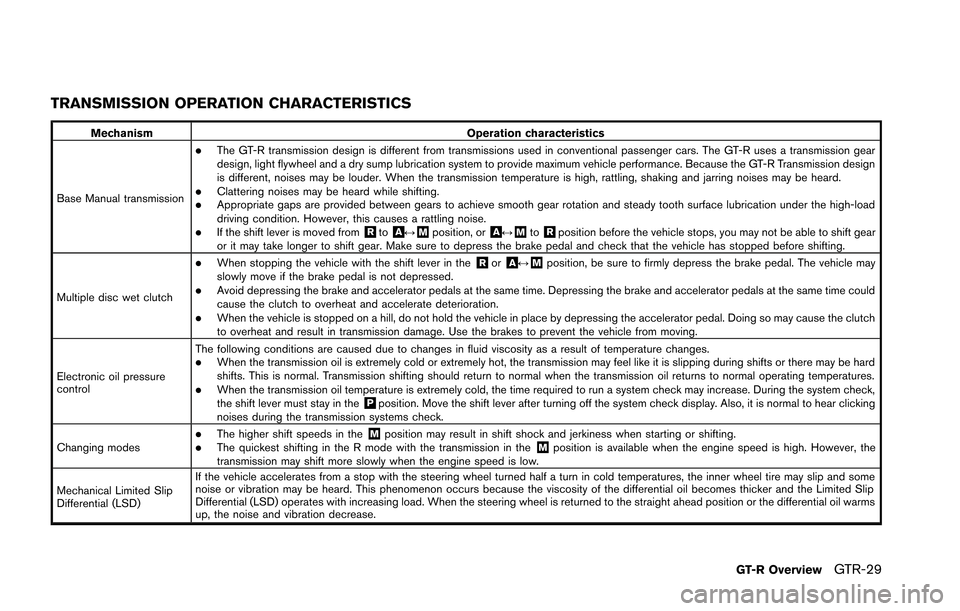
TRANSMISSION OPERATION CHARACTERISTICS
MechanismOperation characteristics
Base Manual transmission
.The GT-R transmission design is different from transmissions used in conventional passenger cars. The GT-R uses a transmission gear
design, light flywheel and a dry sump lubrication system to provide maximum vehicle performance. Because the GT-R Transmission design
is different, noises may be louder. When the transmission temperature is high, rattling, shaking and jarring noises may be heard.
.Clattering noises may be heard while shifting..Appropriate gaps are provided between gears to achieve smooth gear rotation and steady tooth surface lubrication under the high-load
driving condition. However, this causes a rattling noise.
.If the shift lever is moved from&Rto&A↔&Mposition, or&A↔&Mto&Rposition before the vehicle stops, you may not be able to shift gear
or it may take longer to shift gear. Make sure to depress the brake pedal and check that the vehicle has stopped before shifting.
Multiple disc wet clutch
.When stopping the vehicle with the shift lever in the&Ror&A↔&Mposition, be sure to firmly depress the brake pedal. The vehicle may
slowly move if the brake pedal is not depressed.
.Avoid depressing the brake and accelerator pedals at the same time. Depressing the brake and accelerator pedals at the same time could
cause the clutch to overheat and accelerate deterioration.
.When the vehicle is stopped on a hill, do not hold the vehicle in place by depressing the accelerator pedal. Doing so may cause the clutch
to overheat and result in transmission damage. Use the brakes to prevent the vehicle from moving.
Electronic oil pressure
control The following conditions are caused due to changes in fluid viscosity as a result of temperature changes.
.When the transmission oil is extremely cold or extremely hot, the transmission may feel like it is slipping during shifts or there may be hard
shifts. This is normal. Transmission shifting should return to normal when the transmission oil returns to normal operating temperatures.
.When the transmission oil temperature is extremely cold, the time required to run a system check may increase. During the system check,
the shift lever must stay in the&Pposition. Move the shift lever after turning off the system check display. Also, it is normal to hear clicking
noises during the transmission systems check.
Changing modes
.The higher shift speeds in the&Mposition may result in shift shock and jerkiness when starting or shifting..The quickest shifting in the R mode with the transmission in the&Mposition is available when the engine speed is high. However, the
transmission may shift more slowly when the engine speed is low.
Mechanical Limited Slip
Differential (LSD) If the vehicle accelerates from a stop with the steering wheel turned half a turn in cold temperatures, the inner wheel tire may slip and some
noise or vibration may be heard. This phenomenon occurs because the viscosity of the differential oil becomes thicker and the Limited Slip
Differential (LSD) operates with increasing load. When the steering wheel is returned to the straight ahead position or the differential oil warms
up, the noise and vibration decrease.
GT-R OverviewGTR-29
Page 47 of 346
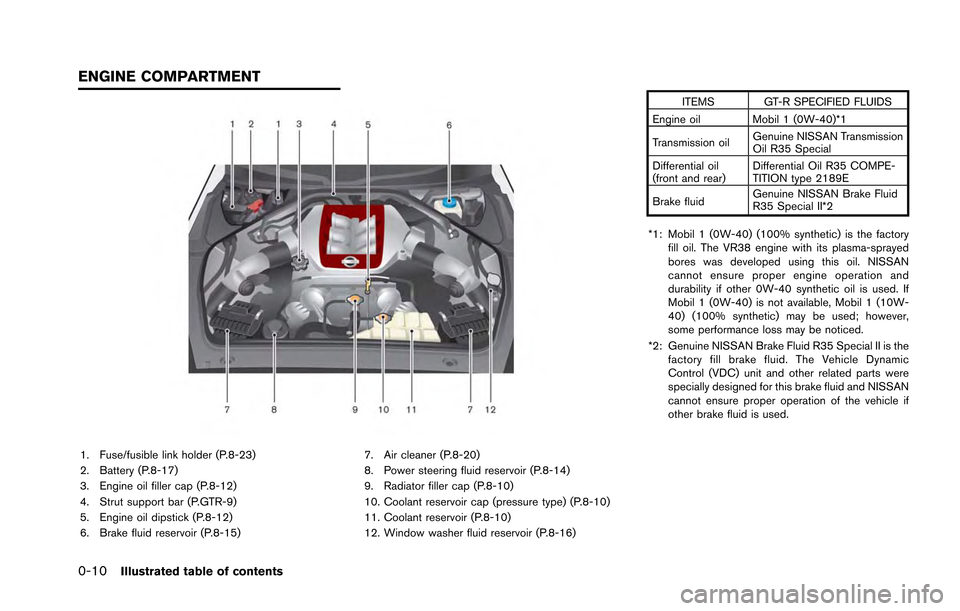
0-10Illustrated table of contents
1. Fuse/fusible link holder (P.8-23)
2. Battery (P.8-17)
3. Engine oil filler cap (P.8-12)
4. Strut support bar (P.GTR-9)
5. Engine oil dipstick (P.8-12)
6. Brake fluid reservoir (P.8-15)7. Air cleaner (P.8-20)
8. Power steering fluid reservoir (P.8-14)
9. Radiator filler cap (P.8-10)
10. Coolant reservoir cap (pressure type) (P.8-10)
11. Coolant reservoir (P.8-10)
12. Window washer fluid reservoir (P.8-16) ITEMS GT-R SPECIFIED FLUIDS
Engine oil Mobil 1 (0W-40)*1
Transmission oil Genuine NISSAN Transmission
Oil R35 Special
Differential oil
(front and rear) Differential Oil R35 COMPE-
TITION type 2189E
Brake fluid Genuine NISSAN Brake Fluid
R35 Special II*2
*1: Mobil 1 (0W-40) (100% synthetic) is the factory fill oil. The VR38 engine with its plasma-sprayed
bores was developed using this oil. NISSAN
cannot ensure proper engine operation and
durability if other 0W-40 synthetic oil is used. If
Mobil 1 (0W-40) is not available, Mobil 1 (10W-
40) (100% synthetic) may be used; however,
some performance loss may be noticed.
*2: Genuine NISSAN Brake Fluid R35 Special II is the factory fill brake fluid. The Vehicle Dynamic
Control (VDC) unit and other related parts were
specially designed for this brake fluid and NISSAN
cannot ensure proper operation of the vehicle if
other brake fluid is used.
ENGINE COMPARTMENT
Page 48 of 346
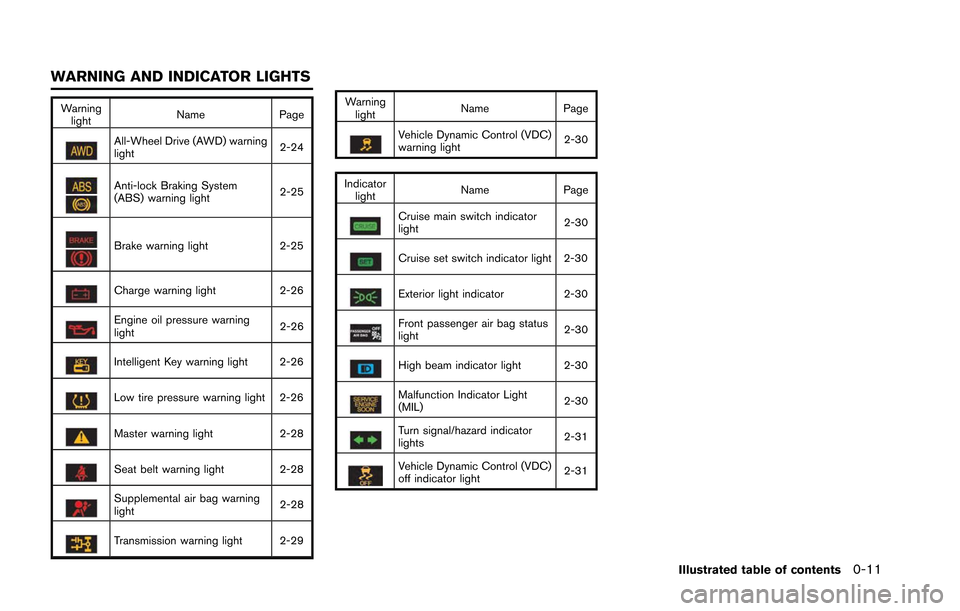
Warninglight Name
Page
All-Wheel Drive (AWD) warning
light 2-24
Anti-lock Braking System
(ABS) warning light2-25
Brake warning light
2-25
Charge warning light 2-26
Engine oil pressure warning
light 2-26
Intelligent Key warning light 2-26
Low tire pressure warning light 2-26
Master warning light
2-28
Seat belt warning light 2-28
Supplemental air bag warning
light 2-28
Transmission warning light 2-29 Warning
light Name
Page
Vehicle Dynamic Control (VDC)
warning light 2-30
Indicator light Name
Page
Cruise main switch indicator
light 2-30
Cruise set switch indicator light 2-30
Exterior light indicator
2-30
Front passenger air bag status
light 2-30
High beam indicator light 2-30
Malfunction Indicator Light
(MIL)2-30
Turn signal/hazard indicator
lights
2-31
Vehicle Dynamic Control (VDC)
off indicator light2-31
Illustrated table of contents0-11
WARNING AND INDICATOR LIGHTS